
Paula Ramiro-Martínez
@paularamiro.bsky.social
Predoctoral researcher at evodynamics lab in Madrid.
Bacterial and plasmid evolution 🫧🧬💻
Bacterial and plasmid evolution 🫧🧬💻
Thirty days of evolution… totally worth it! 🥹

July 22, 2025 at 10:20 AM
Thirty days of evolution… totally worth it! 🥹
Huge thanks to all the authors behind this paper 🙌
@nachodequinto.bsky.social, Laura Jaraba-Soto, Val F.Lanza, @crisherencias.bsky.social, Adrián González Casanova, @penamiller.bsky.social, and @jerorb.bsky.social
So excited to see it finally out! 🥳
@nachodequinto.bsky.social, Laura Jaraba-Soto, Val F.Lanza, @crisherencias.bsky.social, Adrián González Casanova, @penamiller.bsky.social, and @jerorb.bsky.social
So excited to see it finally out! 🥳
July 22, 2025 at 10:10 AM
Huge thanks to all the authors behind this paper 🙌
@nachodequinto.bsky.social, Laura Jaraba-Soto, Val F.Lanza, @crisherencias.bsky.social, Adrián González Casanova, @penamiller.bsky.social, and @jerorb.bsky.social
So excited to see it finally out! 🥳
@nachodequinto.bsky.social, Laura Jaraba-Soto, Val F.Lanza, @crisherencias.bsky.social, Adrián González Casanova, @penamiller.bsky.social, and @jerorb.bsky.social
So excited to see it finally out! 🥳
In summary, plasmids are not just gene delivery platforms.
They significantly boost the availability of mutations, enabling rapid evolution of traits like resistance, metabolism, and virulence, highlighting their role as evolutionary powerhouses of bacterial cells.
PCN is key to evolvability 🫧🤩
They significantly boost the availability of mutations, enabling rapid evolution of traits like resistance, metabolism, and virulence, highlighting their role as evolutionary powerhouses of bacterial cells.
PCN is key to evolvability 🫧🤩
July 22, 2025 at 10:02 AM
In summary, plasmids are not just gene delivery platforms.
They significantly boost the availability of mutations, enabling rapid evolution of traits like resistance, metabolism, and virulence, highlighting their role as evolutionary powerhouses of bacterial cells.
PCN is key to evolvability 🫧🤩
They significantly boost the availability of mutations, enabling rapid evolution of traits like resistance, metabolism, and virulence, highlighting their role as evolutionary powerhouses of bacterial cells.
PCN is key to evolvability 🫧🤩
Do natural plasmids show the same results?
We analyzed 1,598 plasmids (NCBI) 💻 to detect mutations arising during culture growth by comparing sequencing reads to consensus assemblies.
High-copy plasmids exhibited significantly higher mutation rates, just like theory (and experiments!) predicted!
We analyzed 1,598 plasmids (NCBI) 💻 to detect mutations arising during culture growth by comparing sequencing reads to consensus assemblies.
High-copy plasmids exhibited significantly higher mutation rates, just like theory (and experiments!) predicted!
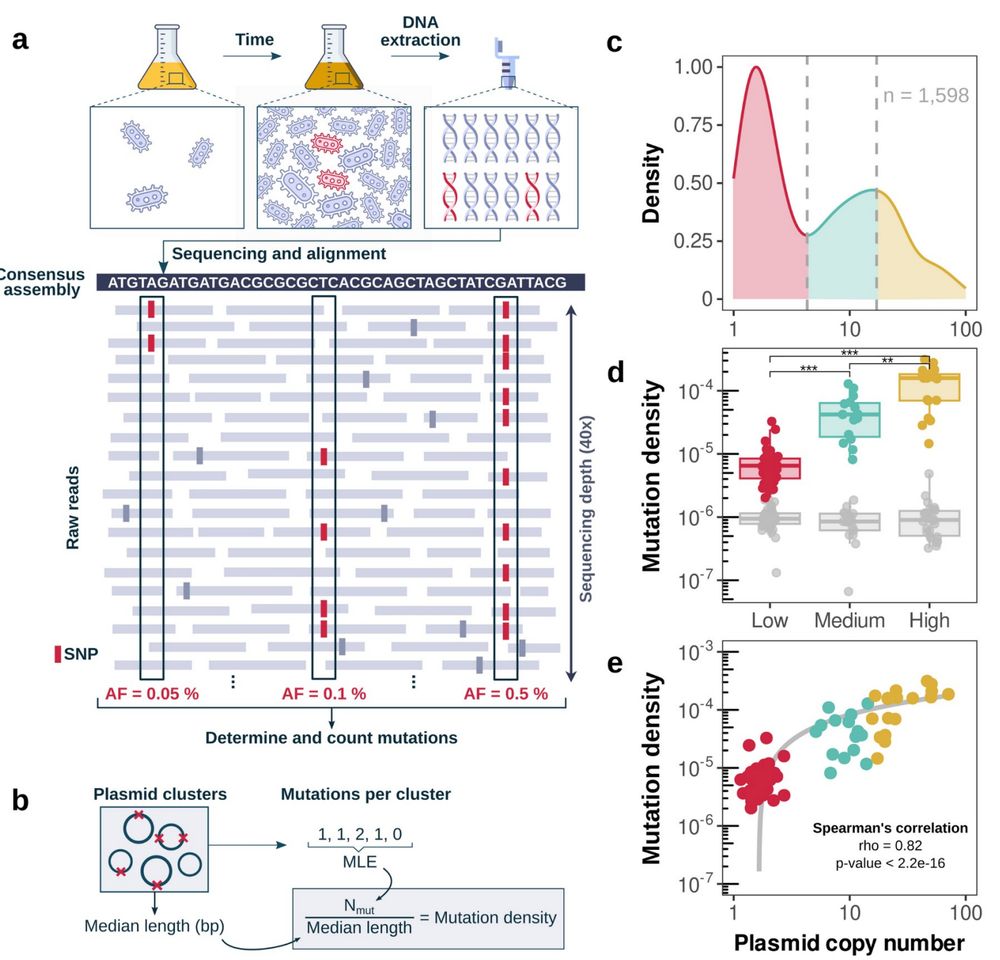
July 22, 2025 at 9:59 AM
Do natural plasmids show the same results?
We analyzed 1,598 plasmids (NCBI) 💻 to detect mutations arising during culture growth by comparing sequencing reads to consensus assemblies.
High-copy plasmids exhibited significantly higher mutation rates, just like theory (and experiments!) predicted!
We analyzed 1,598 plasmids (NCBI) 💻 to detect mutations arising during culture growth by comparing sequencing reads to consensus assemblies.
High-copy plasmids exhibited significantly higher mutation rates, just like theory (and experiments!) predicted!
Experiments confirm it: plasmid mutation rate rises logarithmically with copy number 🚀
At more copies, mutation supply dominates drift! 💥
At more copies, mutation supply dominates drift! 💥
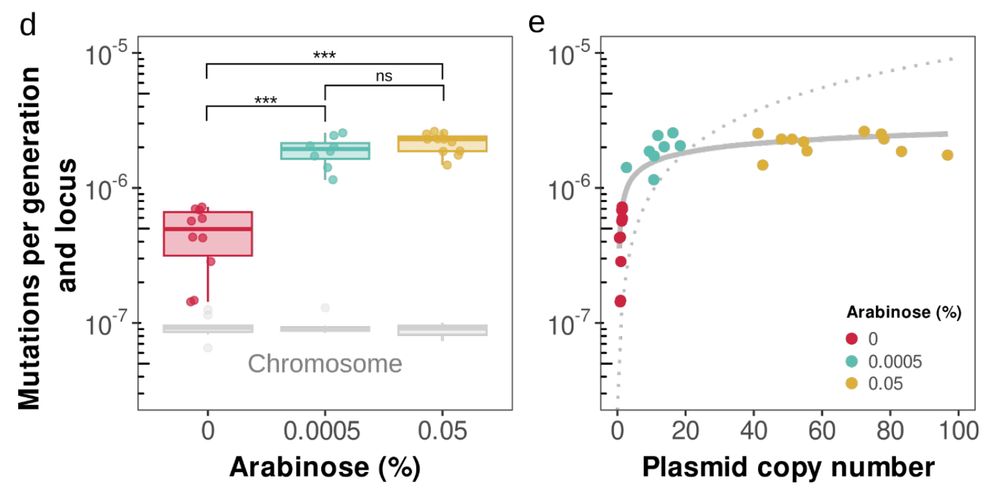
July 22, 2025 at 9:55 AM
Experiments confirm it: plasmid mutation rate rises logarithmically with copy number 🚀
At more copies, mutation supply dominates drift! 💥
At more copies, mutation supply dominates drift! 💥
We conducted a mutation accumulation experiment to test our predictions using a plasmid with a tunable copy number 🫧
We established three PCN conditions: low (~1), medium (~10), and high (~60 copies). Lines were evolved for 30 days under severe bottlenecks.
We established three PCN conditions: low (~1), medium (~10), and high (~60 copies). Lines were evolved for 30 days under severe bottlenecks.
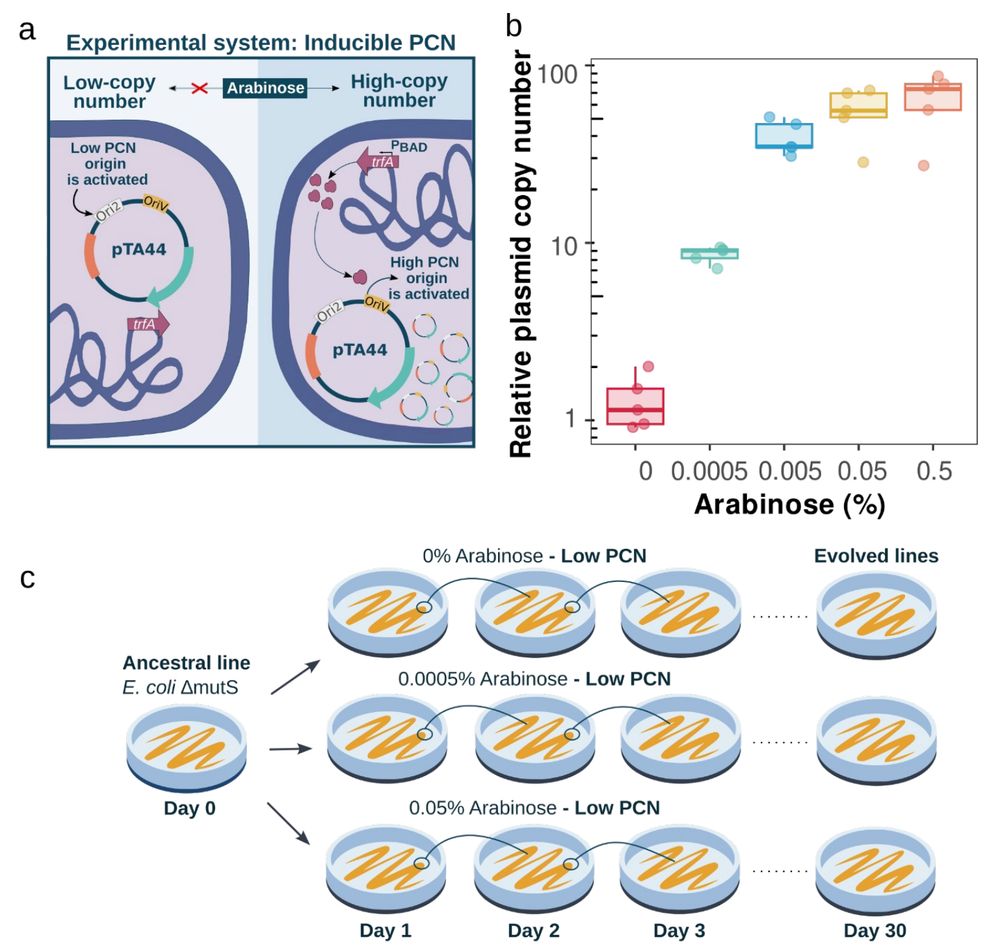
July 22, 2025 at 9:51 AM
We conducted a mutation accumulation experiment to test our predictions using a plasmid with a tunable copy number 🫧
We established three PCN conditions: low (~1), medium (~10), and high (~60 copies). Lines were evolved for 30 days under severe bottlenecks.
We established three PCN conditions: low (~1), medium (~10), and high (~60 copies). Lines were evolved for 30 days under severe bottlenecks.
We modelled plasmid inheritance using a Cannings model and validated it with computational simulations 🧫 Each plasmid copy is like an evolutionary unit, randomly split at division, then copied.
Prediction: the mutation rate rises with PCN, but with diminishing returns, increasing logarithmically.
Prediction: the mutation rate rises with PCN, but with diminishing returns, increasing logarithmically.
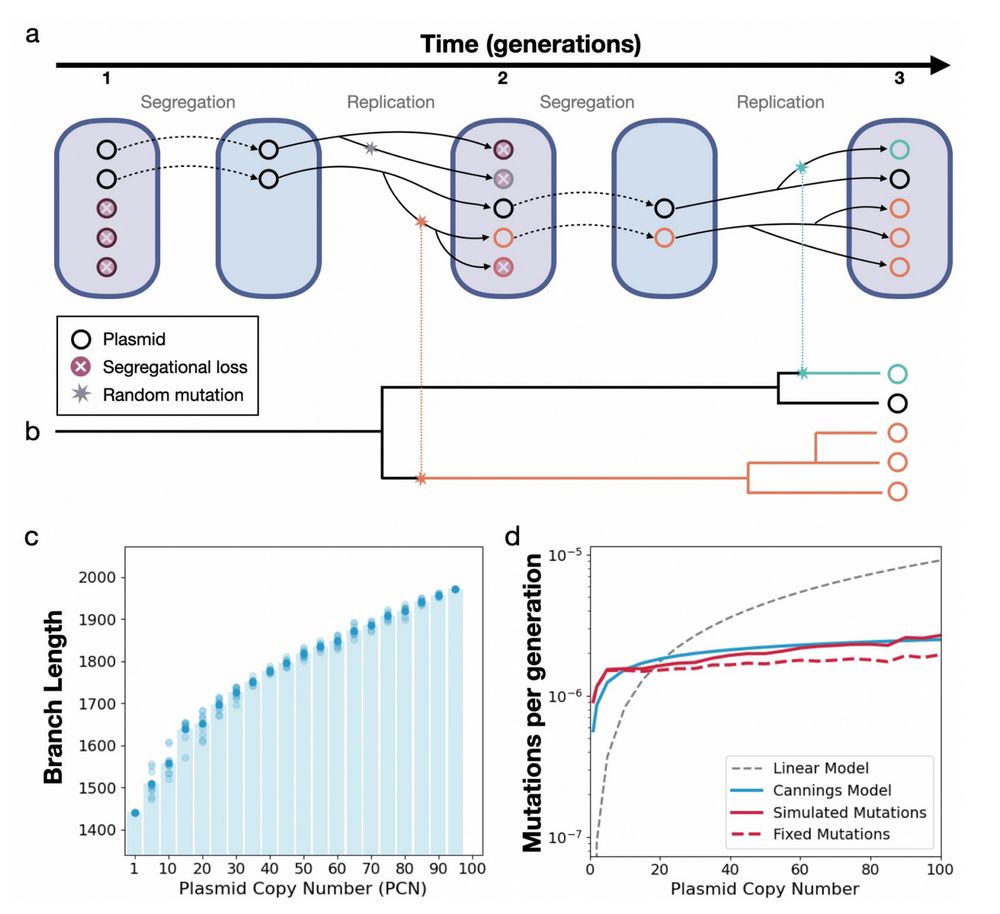
July 22, 2025 at 9:47 AM
We modelled plasmid inheritance using a Cannings model and validated it with computational simulations 🧫 Each plasmid copy is like an evolutionary unit, randomly split at division, then copied.
Prediction: the mutation rate rises with PCN, but with diminishing returns, increasing logarithmically.
Prediction: the mutation rate rises with PCN, but with diminishing returns, increasing logarithmically.
Plasmids face opposing evolutionary forces:
🔹 More copies = more chances to mutate 📈
🔹 But random segregation = drift, purging mutations 📉
So mutation supply ↑ with PCN, but the probability of fixation ↓
Which force dominates: the boost in mutation rate or the loss from segregational drift?
🔹 More copies = more chances to mutate 📈
🔹 But random segregation = drift, purging mutations 📉
So mutation supply ↑ with PCN, but the probability of fixation ↓
Which force dominates: the boost in mutation rate or the loss from segregational drift?
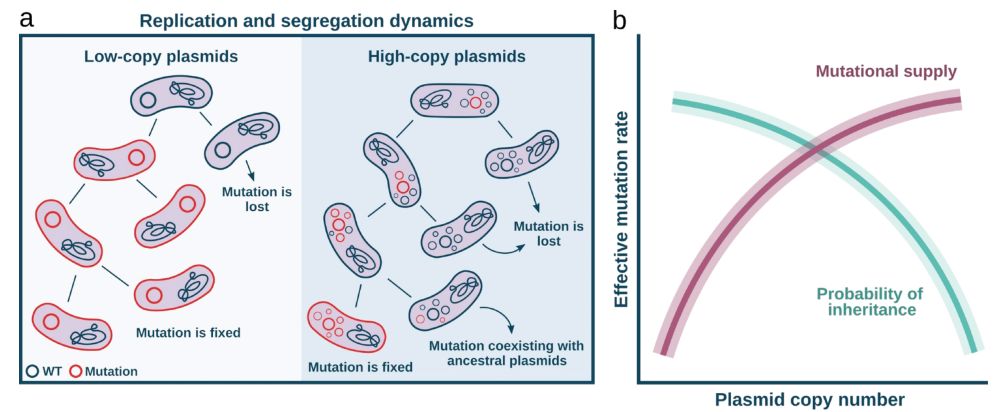
July 22, 2025 at 9:42 AM
Plasmids face opposing evolutionary forces:
🔹 More copies = more chances to mutate 📈
🔹 But random segregation = drift, purging mutations 📉
So mutation supply ↑ with PCN, but the probability of fixation ↓
Which force dominates: the boost in mutation rate or the loss from segregational drift?
🔹 More copies = more chances to mutate 📈
🔹 But random segregation = drift, purging mutations 📉
So mutation supply ↑ with PCN, but the probability of fixation ↓
Which force dominates: the boost in mutation rate or the loss from segregational drift?
Thanks Alberto!!!
July 3, 2025 at 5:27 AM
Thanks Alberto!!!

